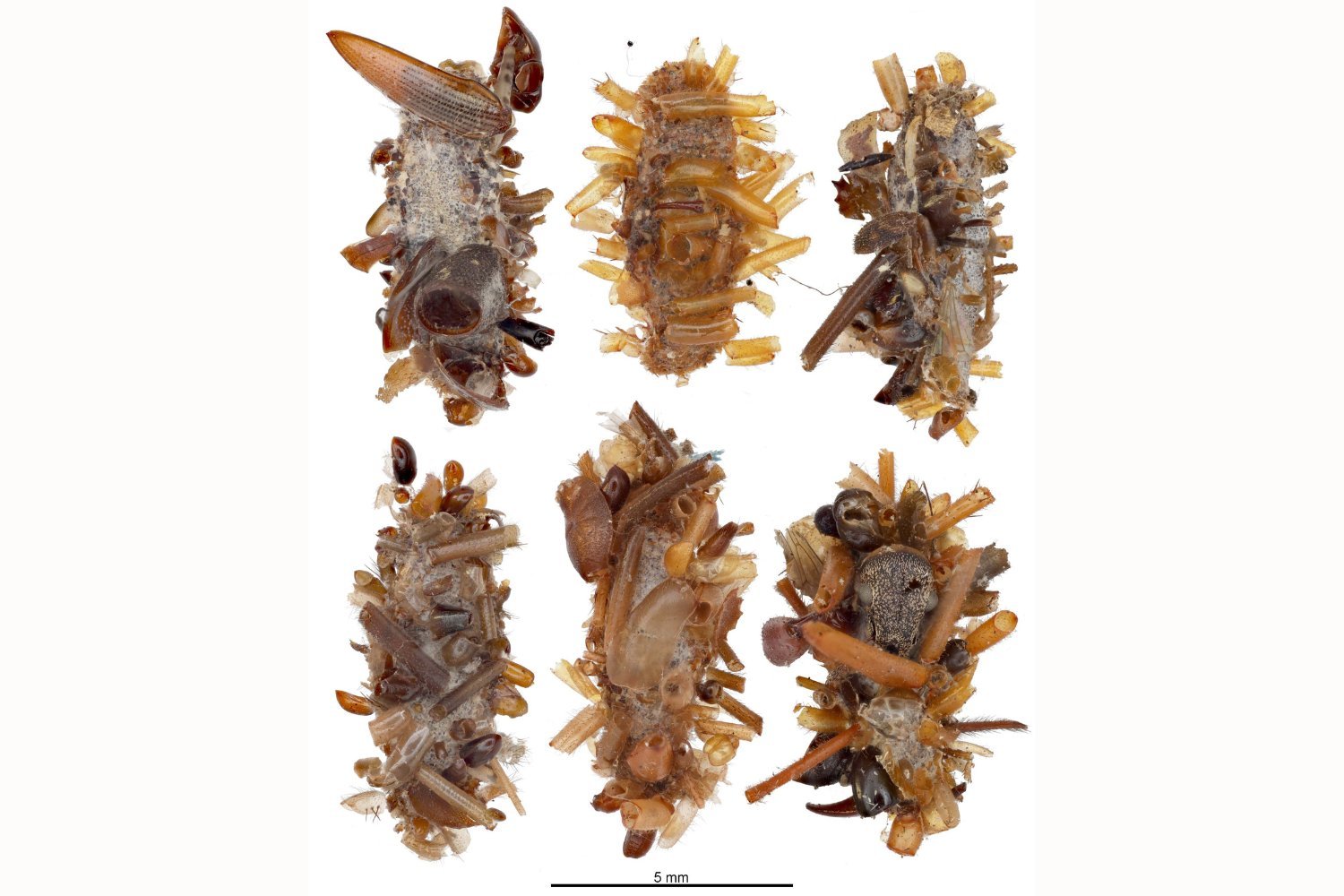Scientists have discovered a rare and ancient lineage of caterpillar in Hawai’i that wears the “bones” of insects as a form of camouflage.
Researchers from the University of Hawaii at Manoa detailed their discovery in a paper published Thursday in Science. The caterpillar—which they’ve dubbed the “bone collector”—uses the disguise to live hidden within a spider’s web, where it can prey upon other small bugs that get stuck inside. Unfortunately, the unique caterpillar’s continued survival is likely under threat, since it’s only known to exist on a single mountain range on one Hawaiian island.
Caterpillars are the larval form of butterflies and moths, which are members of the insect order Lepidoptera. These insects nearly always feed on plants, with less than 0.13% of caterpillars known to be carnivorous (the lowest percentage of any insect order); that alone makes the caterpillar unusual. Somehow, though, its way of life gets even stranger.
Lead researcher Daniel Rubinoff and his team have been studying the insects of Hawai’i’ for decades, particularly the caterpillars and moths that are in the genus Hyposmocoma. He’s helped catalog several different lineages of caterpillar within Hyposmocoma, which currently contains over 350 species discovered to date. These lineages are often distinguished by the type of mobile cases they produce to protect themselves until they can fully mature. So far, however, they and other scientists have found only a single species of caterpillar that belongs to the bone collector lineage.
As the name suggests, these caterpillars attach insect parts—usually the discarded remnants of spider meals—and shed spider skins to the outside of their cage. From within this cage, the caterpillars safely scavenge or prey on the insects unlucky enough to be ensnared by the spider’s web (the webs are typically found inside tree hollows and rock crevices). The camo seems to effectively hide them from the spiders as well, since the team has never found evidence of the caterpillars being eaten by their arachnid landlords.
“In terms of ecology, it’s like they’re literally living in the lion’s den; they’re hiding in Smaug’s lair, stealing his treasure,” Rubinoff told Gizmodo over the phone. “It’s a questionable life choice, but that’s the fun thing about evolution. It doesn’t do what you’d expect simply because we have these expectations that aren’t always accurate. We assume life is going to be the same everywhere. But Hawaii is an isolated place, and the things that have gotten here have really thrown the rulebook out in terms of the ways they’ve evolved.”

Rubinoff first came across these caterpillars in 2008, though his research into them has been stymied by a lack of consistent funding. In that time, he and others have only found bone collectors living within a 10 mile-long (16-kilometer) area of forest in the Waiʻanae mountain range on the island of Oʻahu. But based on their genetic analysis, the origins of its lineage date back at least six million years ago—three million years before the actual formation of the island they currently live on. That suggests that these insects were once more widely distributed on older islands, with an ancestor only later arriving to Oʻahu.
There are probably several factors behind the caterpillars’ shrinking population range, such as deforestation and other human-caused disruptions. But the largest reason for the caterpillar’s decline is likely the mass introduction of non-native invasive species to the islands, according to Rubinoff.
“What’s really killing us is that we have these forest reserves that are mostly invasive species now. And they essentially become biological deserts because all the trees are a conglomeration of things from around the world. The insects are brought in from around the world. And the birds are all from other places,” he explained. “And so what you end up with is a community that native Hawaiian species can’t survive in anymore.”
The caterpillars have been able to adapt somewhat to these changes, since they’re able to successfully live alongside and fool non-native spider species. But given their small distribution, we very well could be seeing the last days of this ancient lineage soon. If so, it would be another example of Hawai’i being the “extinction capital” of the world.
“This is the last sort of holdout for this entire lineage. And that’s a little bit sad to think about. It’s miraculous that they’re still hanging on there, but we really do need to do more to save them,” Rubinoff said.
Rubinoff is hoping that his team’s research can spur more resources and funding dedicated to saving and studying these utterly unique insects.
“We absolutely want to understand the genomic basis for how these caterpillars perceive the world. Because it is incredible that they’re able to discern these different body parts from the sort of debris that they live in, isolate them, recognize their sizes, carve them into the sizes that they eat, and attach them to their cases. That’s not an accident. That’s got to have a really profound sort of genetic change from other caterpillars,” he said. “And then on top of that, the metabolic changes that allow them to eat meat like that have got to be huge, and also very rare.”




